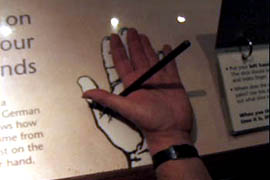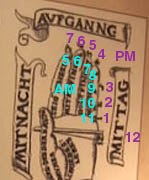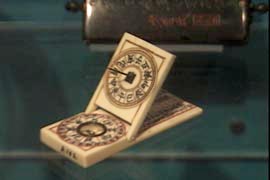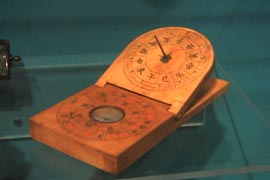Sundials


|
Simple and beautiful, sundials are one of the few historical tools we find in use today. The sundials in the Adler collection come in many shapes, sizes and materials. We have included several of our more interesting types in this virtual exhibit, along with common ones like the stone English garden sundial shown above.
Sundials come in many sizes. The brass sundials above are about two feet high. The ivory and wood sundials here were "pocket" sundials, early "pocket watches."
The bowl sundial is about one foot across. The record, at least for Adler sundials, is the familiar sundial that has greeted visitors in front of the Adler Planetarium for decades. It was moved during the constructions of the new sky pavillion, and now it's new home is few yards north and east of it's old position.
Come and visit us --any "time"! |
Back to Universe in Your Hands (for armillary spheres & astrolabes)
All images copyright 1999, The Adler Planetarium and Astronomy
Museum.
This page, including all components (writing, graphics, photography
and videography), was designed and executed by Lisa Schuyler Jewell.
Any inquiries about the Adler site should be directed to webmaster@adlerplanetarium.org
 Sundials
consist of at least one surface, with a dial denoting the hours (The
pentagonal sundial on the left is a dodecahedron designed to tell time
at 10 different latitudes). Sundials are labelled with the morning hours
on the left and the evening hours on the right. A stick, called a gnomon,
is set into the surface at the same angle of the user's latitude. In
Chicago, we set our gnomons around 42 degrees. In the northern hemisphere,
the gnomon must point to the north in order for the sundial to work.
In the southern hemispheres, the gnomons need to point south. Where
the shadow falls determines the time.
Sundials
consist of at least one surface, with a dial denoting the hours (The
pentagonal sundial on the left is a dodecahedron designed to tell time
at 10 different latitudes). Sundials are labelled with the morning hours
on the left and the evening hours on the right. A stick, called a gnomon,
is set into the surface at the same angle of the user's latitude. In
Chicago, we set our gnomons around 42 degrees. In the northern hemisphere,
the gnomon must point to the north in order for the sundial to work.
In the southern hemispheres, the gnomons need to point south. Where
the shadow falls determines the time.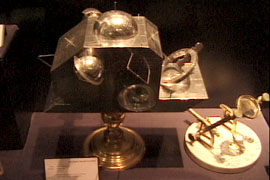 Sundials
are made of many materials. Both the pentagonal sundial above, and this
more intricate multi-sided sundial to the right, and the Chinese bowl
sundial below are made of brass. This is an expensive choice for common
people, so many sundials in were make of stone. The other two Chinese
sundials below were made of ivory and wood. You
can make a sundial of your hand, too. Hold a stick between your thumb
and forefinger of your hand at an angle equal to your latitude, and
face south, so that the gnomon points north. In the morning, you need
to use your left hand. In the afternoon, you need to use your right
hand. Look to see where the shadow falls. In the example below left,
the "sundial" reads 11 o'clock in the morning. The diagram
below right shows how to read the "dial".
Sundials
are made of many materials. Both the pentagonal sundial above, and this
more intricate multi-sided sundial to the right, and the Chinese bowl
sundial below are made of brass. This is an expensive choice for common
people, so many sundials in were make of stone. The other two Chinese
sundials below were made of ivory and wood. You
can make a sundial of your hand, too. Hold a stick between your thumb
and forefinger of your hand at an angle equal to your latitude, and
face south, so that the gnomon points north. In the morning, you need
to use your left hand. In the afternoon, you need to use your right
hand. Look to see where the shadow falls. In the example below left,
the "sundial" reads 11 o'clock in the morning. The diagram
below right shows how to read the "dial".